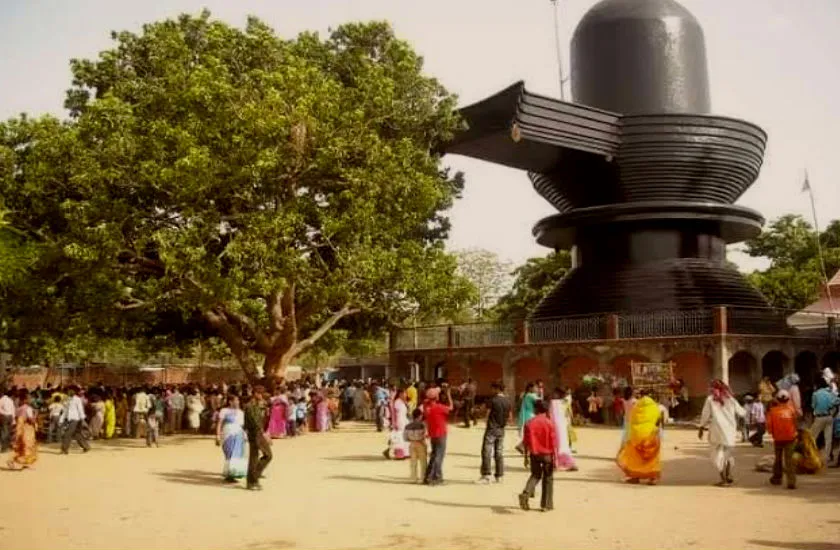Set on the plains of Bagodar in Giridih district, Jharkhand, Harihar Dham is a sacred shrine where devotees worship Lord Shiva and Lord Vishnu, known here as Harihar, uniting both deities. Built in recent times, with construction starting in 1990, this temple is famed for its 65-foot Shivlinga, one of the tallest in the world.
Notable Fact: The temple’s 65-foot Shivlinga, carved from a single dark stone, is one of the tallest Shiva lingas globally, standing uncovered under the open sky.
Overview of Harihar Dham
Harihar Dham stands in Bagodar, 60 kilometers from Giridih town, along National Highway 100, a key shrine for Shaivism and Vaishnavism. Known for its 65-foot Shivlinga, measuring 4 meters wide at the base, it follows a simple, open design with no enclosing structure. The temple complex, spanning 25 acres, includes smaller shrines for Parvati, Ganesh, Hanuman, and Vishnu. Devotees offer milk, bilva leaves, and water, believing Shiva grants their prayers. The temple trust, formed in 1996, maintains the site, adding pathways and facilities for thousands of pilgrims yearly. It is a major stop for Hindus, tied to Jharkhand’s tribal and spiritual heritage.
History of Harihar Dham
Records state the temple’s construction began in 1990, initiated by local devotees and priests under the leadership of the Harihar Dham Trust. Completed in 1996 after six years, the 65-foot Shivlinga was carved from a single dark stone sourced from local quarries. Historical accounts are sparse, but oral tales claim a sage, centuries ago, meditated here and saw Shiva’s divine light, marking the land as sacred. Another local story tells of a farmer who, in the 1980s, prayed for rain during a drought, and showers followed, prompting the temple’s creation. No ancient inscriptions or ruins predate the 1990s structure, and the site faced no recorded invasions. In 2005, the trust expanded the complex, adding four smaller shrines and a pond. The name Harihar, combining Vishnu (Hari) and Shiva (Har), reflects unity between Vaishnava and Shaiva traditions. Since 2010, the temple has hosted over 100,000 visitors during festivals like Shravan Mela, solidifying its place as a pilgrimage hub.
Architecture of Harihar Dham
Harihar Dham, set on a 25-acre plot along NH-100, follows a minimal North Indian style, with no shikhara or dome. Its sanctum is the 65-foot Shivlinga, 4 meters wide, carved from dark granite, weighing approximately 200 tons, standing open under the sky. The linga’s surface is smooth, unadorned, with a 10-meter-wide circular platform around it, built from concrete. Four smaller shrines, each 3 meters by 3 meters, house stone idols of Parvati (2 feet tall), Ganesh (1.5 feet), Hanuman (2.5 feet), and Vishnu (2 feet), arranged in a square around the linga. The shrines’ walls, made of whitewashed brick, bear 10 carved panels, each 1 meter by 0.5 meters, depicting Shiva’s Tandava dance and Vishnu’s Dashavatara, painted in white and ochre. The entrance is a 5-meter-wide stone arch, 3 meters tall, inscribed with “Harihar Dham” in Hindi. A pond, 10 meters by 10 meters, lies 50 meters east, used for ritual baths. The yard, paved with rough tiles, spans 5000 square meters, accommodating 10,000 devotees during festivals.
Sculptures of Harihar Dham
The temple’s core is the 65-foot Shivlinga, a plain granite monolith with no carved faces, symbolizing Shiva’s formless essence. Parvati’s idol, in a side shrine, is a 2-foot-tall black stone figure holding a lotus. Ganesh’s 1.5-foot idol, also black stone, holds a modak and axe. Hanuman’s 2.5-foot idol, painted red, carries a mace, carved from sandstone. Vishnu’s 2-foot idol, black stone, holds a conch and discus. The outer walls of the shrines feature 10 carved panels, each showing myths like Shiva’s meditation or Vishnu’s Narasimha avatar, etched 5 centimeters deep. The arch at the entrance has two floral carvings, 0.5 meters wide, unpainted. No ancient sculptures exist, as the temple is modern, but the linga’s sheer scale draws eyes, reflecting skilled extraction work from the 1990s.
Information for Travelers
How to Reach Harihar Dham, Giridih
In Bagodar, 60 km from Giridih town, on NH-100, the temple is reached by bus, taxi, or car, set by fields and hills.
By Air
Birsa Munda Airport, Ranchi, 160 km away, connects to Delhi (2.5 hours), Kolkata (1.5 hours), Mumbai (2 hours), Bangalore (2.5 hours). Taxis from Ranchi to Bagodar take 3 hours.
By Train
Giridih Station, 60 km away, links to Dhanbad (2 hours) and Ranchi (3 hours) with three daily trains. Parasnath Station, 30 km away, connects to Delhi (12 hours), Kolkata (5 hours), Patna (4 hours). Autos from either station to Bagodar take 1 hour.
By Road
Bagodar connects to Giridih (60 km, 1.5 hours), Dhanbad (70 km, 2 hours), Ranchi (160 km, 4 hours) via NH-100. State buses cost ₹50–200; private buses run hourly. Taxis cost ₹1500–4000. Local rickshaws in Bagodar to the temple cost ₹20–50, flat terrain, no steps.
Hours and Entry
Open daily, 5:00 AM–8:00 PM. Free entry; puja costs ₹50–300. No photography near the linga. Wear clothing covering shoulders and knees; men wear kurtas or dhotis, women wear sarees or suits.
Best Time to Visit
October to March, temperatures 14–22°C, suits visits. Weekdays see 500 visitors; weekends, 2000. Shravan (July–August) and Mahashivratri (February) draw 200,000, book early. Avoid April–June, 25–40°C.
Nearby Attractions
Parasnath Hill, 30 km away, Jain site with 27 km trek to 24 Tirthankara shrines, 1000 daily visitors.
Usri Falls, 70 km in Giridih, 20-meter waterfall, 500 visitors daily.
Khandoli Dam, 65 km, 100-hectare lake, boating costs ₹50, 2000 visitors weekly.
Madhuvan, 35 km, Jain temples with 2nd-century carvings, 300 visitors daily.
Jharkhand Dham, 40 km, Shiva shrine with 10-foot linga, 500 tribal devotees weekly.











